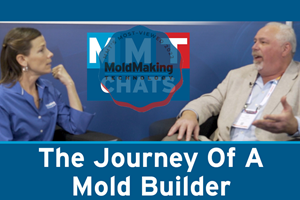Bill Matteson: Climbing the Moldmaking Ladder
A long and diverse career takes this industry veteran from the shop floor to the classroom.
Moldmaking is in Bill Matteson's blood. Perhaps it was growing up in a small town merely twenty-five miles from Meadville, PA—which has the distinction of housing the highest concentration of tool shops per capita in the nation. Or maybe his neighbor who had carved out a decent living working at a tool shop inspired him. No matter his inspiration, Matteson's lifelong journey has taken him down a number of moldmaking paths to his current position as tool die and mold design coordinator at Erie, PA-based CAMtech—a two-year technical college offering an associate's degree in tool die and mold design.
Back in high school, Matteson took college prep courses before changing his mind in his senior year. After graduating in 1975, he took a job in a Ford garage, but after seeing what the senior mechanics made, decided to try his luck in a factory. "I went to work for a local spring manufacturer," he recalls. "After a year there I received a thirty-five cent raise the same day minimum wage went up twenty-five cents. I decided I should go back to school. I noticed that my neighbor—who was about twelve years older than I—worked in a tool shop making a good living. This neighbor is now a partner in a thirty-man moldmaking shop."
The First Step
Witnessing his neighbor's success inspired Matteson to give tool and die a try. "I took a night class at the local vo-tech, and after the first class was over a local shop—Meadville Precision—a manufacturer of high-precision plastic injection molds, custom molded plastic components and complete turnkey assemblies—hired me to change parts on a Series Two NC Bridgeport," he recalls. "After working there six months, my wages doubled and I had learned to set up the machine and several drill presses."
Then, Matteson decided it was time for a change of pace, and put in an application at the Cooper Energy Plant (Ajax) in Corry, PA—a builder of engines and compressors for the natural gas industry. "They hired me to work in their machine shop," he recalls, "where I was put on a new forty-eight-inch vertical turret lathe."
After a couple of years, Matteson was switched to a roustabout position (an all-around person) where he ran every piece of equipment they had—including CNC lathes, horizontal mills and vertical lathes. He also began to train operators on these machines. After eight years the company relocated to Ohio, so once again Matteson was looking for work. "The Cooper Energy plant laid off often and when it did, I went back to the tool shops in Meadville to work. I realized that building plastic injection molds was what I wanted to do."
Learning the Ropes
In 1987 Erie, PA-based Johnson Controls' Engineering/Plastics division—a builder of radiation tank molds for automobiles as well as soda bottle molds—hired him as a CNC lathe hand; and after six months he was promoted to CNC lathe operator, and then CNC mill operator. "Working second shift and running the mills was pretty boring so I conned a few programmers into showing me how to get started with Computer Vision software (which was later bought out by Unigraphics)," he notes.
After running mills for a year and a half, the company purchased one of the first graphite mills in the country, which he had the opportunity to program and run. Things went smoothly for a few years until Johnson Controls decided to sell off its divisions. Once again, Matteson decided to branch out in a different direction. He realized that no matter what path he took, he always ended up training his peers after he mastered a technique. "The National Institute of Flexible Manufacturing (NIFM; Meadville, PA)—a school offering diploma-based programs—hired me to teach CNC mill, CNC lathe and SmartCAM," he comments. "This school, now known as the Precision Manufacturing Institute (PMI), also leased time on their equipment and had the instructors help companies run them. During that time, I also learned Esprit software." Chip Blaster (Meadville, PA)—a manufacturer of high-pressure coolant systems for NC machines—was next door, which allowed Matteson and his students the opportunity to do a great deal of test cutting for the company. "After three years at NIFM, I went to Chip Blaster as their technical person," he says. "I traveled and helped their customers use high-pressure coolant, which is better for producing parts." After a year he returned to NIFM/PMI for another few years, where he assisted in developing a seven-week CNC mill operator course. And—since his predecessor taught Mastercam—he had another software program to learn.
"That was a nice software," he notes. "Next, I decided to tackle Unigraphics and do some dabbling in Pro/Engineer," he notes. "And because I could run Esprit software I was asked to teach wire EDM." His abundant software knowledge would lead him to his next position.
Educator Extraordinaire
In 2001, Matteson's long and winding career journey ended at CAMtech, where he once again wears many hats. His primary responsibilities are as tool die and mold design program coordinator and instructor. He also helps set the school's curriculum, lines up part-time instructors and advises students.
"I applied to CAMtech knowing they had state-of-the art equipment and software," he states. Besides helping to develop the curriculum, Matteson finds it very rewarding to take a "person who had never worked into a tool and die shop and turn them into someone who would be an asset to a modern shop. We integrate the training process with software and hardware, and mold design and building. Our students also start out using high-end software like Pro/E and UG—and since it is all brand-new for them they don't realize how difficult it is. There are no preconceived notions."
In his never-ending quest to keep current with the latest technology, Matteson visits at least five different technical schools per year to brush up on the newest software offerings; and visits numerous trade shows. Additionally, he has pushed a nonmoldmaking curriculum through to make his students well-rounded. "CAMtech students also have basic English/writing and sociology-type classes as part of their associate's degree to help them work and communicate with other coworkers and customers," he says. "I think it's very important that they are educated technically as well as socially."
Matteson acknowledges there is much work ahead as this new school fine-tunes its curriculum and moves ahead into the future. "We still have a long way to go as we show our students how to automate CAD/CAM and CNC EDM & CNC milling to work toward unattended machining," he says. "I am excited to be training people for the future."
Related Content
Leading Mold Manufacturers Share Best Practices for Improving Efficiency
Precise Tooling Solutions, X-Cell Tool and Mold, M&M Tool and Mold, Ameritech Die & Mold, and Cavalier Tool & Manufacturing, sit down for a fast-paced Q&A focused on strategies for improving efficiencies across their operations.
Read MoreHow to Improve Your Current Efficiency Rate
An alternative approach to taking on more EDM-intensive work when technology and personnel investment is not an option.
Read MoreMMT Chats: California Mold Builder Discusses the Difficulties with Silicone Molding and the Power of the Magic 8 Ball
MoldMaking Technology Editorial Director Christina Fuges sits down with M.R. Mold President and Owner, Rick Finnie, to discuss how he began his moldmaking career, M.R. Mold's LSR Education, and the struggles of working with silicone. This episode is brought to you by ISCAR with New Ideas for Machining Intelligently.
Read MoreMMT Chats: The Connection Between Additive Manufacturing Education and ROI
This MMT Chat continues the conversation with Action Mold and Machining, as two members of the Additive Manufacturing team dig a little deeper into AM education, AM’s return on investment and the facility and equipment requirements to implement AM properly.
Read MoreRead Next
Fred Steil: SPE's 2004 Moldmaker of the Year
Accolades abound from the Society of Plastics Engineers for this industry veteran who has spent his life giving back to the industry.
Read MoreReasons to Use Fiber Lasers for Mold Cleaning
Fiber lasers offer a simplicity, speed, control and portability, minimizing mold cleaning risks.
Read MoreHow to Use Strategic Planning Tools, Data to Manage the Human Side of Business
Q&A with Marion Wells, MMT EAB member and founder of Human Asset Management.
Read More









.jpg;maxWidth=300;quality=90)











